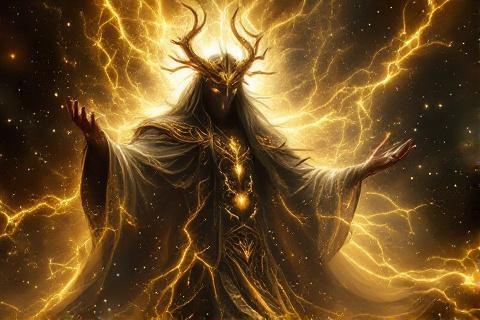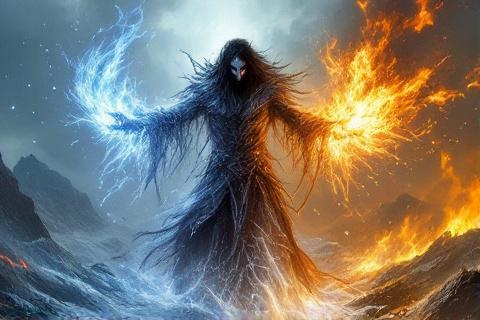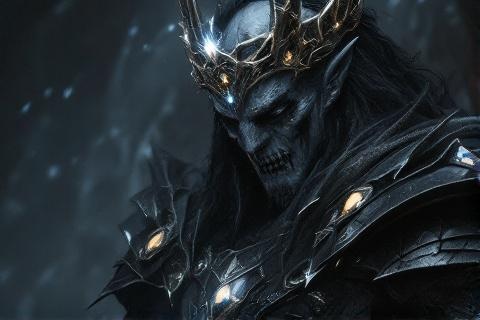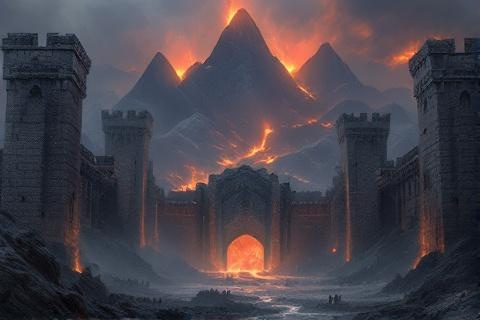
Melkor: The First Dark Lord
From Vala to Morgoth—The Fall into Evil
Origins as a Vala

In the timeless halls before the beginning of days, Eru Ilúvatar brought forth
the Ainur, the Holy Ones, from his thought. Among these spiritual beings, Melkor
stood as the mightiest, gifted with the greatest power and knowledge. Ilúvatar
bestowed upon him exceptional understanding and strength, marking him as the
most splendid of all the Ainur. His vast intelligence and creative power were
unmatched among his peers.
Unique among the Ainur, Melkor possessed portions of all the gifts and powers
that Ilúvatar distributed among his fellow Valar. While others
specialized in particular aspects of creation such as water, wind, or craft,
Melkor could understand and manipulate all these elements. This breadth of
ability made him incredibly versatile but also led to a dangerous pride in his
own capabilities. His mastery extended across music, matter, and thought itself.
The original purpose intended for Melkor was noble beyond measure, as he was
meant to be the greatest force for good in the history of Arda. Ilúvatar
designed him to lead the other Valar in their great works, using his tremendous
powers to shape and enhance the world in harmony with the Creator's vision. His
role was to be the foremost among the Valar in bringing light and life to Arda,
working in concert with his brethren to create beauty and order.
The Seeds of Discord
The first signs of Melkor's fall appeared during the Great Music of the Ainur,
when his desire to create independent themes led him to introduce discord into
the grand harmony. Rather than weaving his music in accordance with Ilúvatar's
themes, he began to devise his own melodies that clashed with the original song.
This act of rebellion demonstrated his growing separation from the divine plan
and his peers, marking the beginning of discord in the universe.
As time progressed, Melkor's pride swelled beyond measure, and his ambition to
dominate others became all-consuming. He viewed the other Valar not as siblings
or collaborators but as potential subjects to be ruled. His tremendous powers
and knowledge, rather than being used for the benefit of all, became tools in
his quest for absolute dominion over Arda. This corruption of purpose led him to
view every creation and every being as something to be dominated rather than
nurtured.
Melkor's obsessive search for the Flame Imperishable, the secret fire of
creation that resided with Ilúvatar alone, became a driving force in his fall
from grace. He sought this power in the Void before the beginning of Arda,
believing he could use it to create beings of his own. This futile quest
demonstrated his fundamental misunderstanding of his role as a sub-creator and
his desire to usurp the position of Ilúvatar himself.
The early days of Arda were marked by constant conflicts between Melkor and his
fellow Valar. While they worked to build and order the world according to the
vision they had seen in the Music, Melkor repeatedly destroyed their works. He
fought particularly fierce battles with Manwë, his brother in the thought of
Ilúvatar, and Ulmo, Lord of Waters, as they attempted to protect their creations
from his destructive influence.
Power and Abilities

Among Melkor's most terrible powers was his absolute mastery over the extremes
of temperature. He could generate intense cold that froze the seas and create
heat that melted mountains. This control over thermal extremes allowed him to
reshape vast regions of Arda, creating wastelands of ice in the north and
regions of burning heat in the south. The great cold of Helcaraxë and the fires
of Thangorodrim stood as testament to this fearsome ability.
Melkor possessed an unprecedented ability to corrupt and twist other beings to
his will, a power that would have devastating consequences for Arda. Through
this ability, he could alter the very nature of creatures and spirits, turning
them from their original purpose to serve his dark designs. This corruption
extended beyond mere influence, allowing him to fundamentally change the
physical and spiritual essence of his victims, as demonstrated in the creation
of Orcs from captured Elves.
In terms of raw physical might, Melkor stood unmatched among the Valar during
the First Age. His tremendous strength allowed him to wrestle
with Ungoliant, survive battles with multiple Valar
simultaneously, and engage in devastating physical combat with
Fingolfin, High King of the Noldor. The
sheer power he possessed made him a terrifying opponent in direct confrontation,
though each use of his strength diminished him slightly.
Perhaps most insidious among Melkor's powers was his ability to destroy and
alter the works of others. He could not only demolish what his fellow Valar had
built but could twist and corrupt their creations into dark parodies of their
original form. This power extended to the very fabric of Arda itself, allowing
him to taint the original design of the world and create lasting imperfections
in the physical realm.
The Marring of Arda
Melkor's corruption of Arda's original design represented one of the most
fundamental changes to the world's nature. During the initial shaping of Arda,
he interfered with and marred the perfect symmetry and beauty that had been
planned. His actions led to the world becoming flawed and imperfect, introducing
chaos and discord into what should have been a harmonious creation. The very
geography of Middle-earth bore the scars of his
destructive influence.
The Dark Lord's power to create extreme environments reshaped entire regions of
Middle-earth. He raised massive mountain ranges through volcanic activity and
created vast ice fields in the north. The Iron Mountains and the dreaded peaks
of Thangorodrim stood as monuments to his destructive power, while the
Helcaraxë's grinding ice sheets made the northern wastes nearly impassable.
These geographical alterations would influence the development of all peoples in
Middle-earth for ages to come.
One of Melkor's most insidious acts was the spreading of his own essence
throughout the physical matter of Arda itself. This action, known as the Marring
of Arda, meant that his evil influence became woven into the very fabric of the
world. All things in Middle-earth, whether living or inanimate, carried some
trace of his corruption, making the physical world itself susceptible to evil
and decay. This fundamental corruption would persist long after his eventual
banishment into the Void.
From Melkor to Morgoth

The name 'Morgoth,' meaning 'The Black Enemy' in Sindarin, was given to him by
Fëanor, the greatest of the Noldor Elves, after the theft
of the Silmarils and the murder of
Finwë. This new name marked a crucial moment in the history
of Arda, as it recognized that Melkor had become something entirely different
from his original nature as a Vala. The name would become the one by which he
was known throughout the remainder of the First Age and beyond.
As Morgoth's evil grew, his physical form became increasingly dark and terrible
to behold. Once beautiful and noble in appearance, he chose to incarnate himself
in a form of tremendous size and terrifying aspect. His hands were eternally
burned black from his theft of the Silmarils, and his crown was adorned with
these stolen jewels. The progressive darkening of his physical form reflected
the corruption of his spirit within.
The corruption of Morgoth's nature became permanent and irreversible, marking a
point of no return in his fall from grace. Unlike other Valar who could shift
their forms at will, he became bound to his dark physical form, a limitation
that came with his choice to dominate and control the physical matter of Arda.
His power, though still immense, became increasingly focused on destruction and
domination rather than creation.
The burning of the ships at Losgar and the first kinslaying at
Alqualondë demonstrated the full extent of Morgoth's
corrupting influence, even when he was not directly present. These tragic
events, involving the Noldor Elves who followed Fëanor, showed how his evil
could spread through the actions of others. The destruction of the ships
stranded many of the Noldor in Aman, forcing them to make the treacherous
crossing of the Helcaraxë, while the kinslaying marked the first time Elves had
slain other Elves.
Fortresses of Darkness

Utumno, Morgoth's first great fortress, was constructed in the
far north of Middle-earth during the Years of the
Lamps. This vast stronghold, delved deep into the
earth, became the first realm of concentrated evil in Arda. Its countless halls
and chambers housed horrors beyond imagination, and from this base, Morgoth
launched his early attacks against the works of the Valar. The fortress was
eventually destroyed during the Battle of the Powers, but its evil influence
lingered in the lands around it.
Following the destruction of Utumno, Morgoth built Angband as
his second great stronghold, initially intended as an outlying fortress to his
first realm. Located in the Iron Mountains beneath the three peaks of
Thangorodrim, Angband became his primary stronghold during the Wars of
Beleriand. Its iron gates, massive towers, and deep dungeons made it nearly
impregnable, serving as the seat of his power throughout most of the First Age.
The dungeons of Morgoth's fortresses were places of unimaginable horror and
suffering. These deep pits housed countless prisoners, including Elves who would
be twisted into the first Orcs, and later, Men who fell into his clutches. The
dungeons extended far beneath the earth, and within them, Morgoth conducted his
most terrible experiments and tortures. Many who entered these pits never
emerged, and those who did were forever changed by their experiences.
Under Morgoth's banner gathered some of the most terrible creatures in the
history of Arda. The Balrogs, spirits of fire who had followed him from the
beginning, became his most feared servants. These demons of shadow and flame
served as his elite warriors and commanders, striking terror into all who
opposed them. Their loyalty to Morgoth never wavered, and they remained his most
powerful allies throughout his reign.
The development of Morgoth's underground realm represented a dark mirror of the
beautiful kingdoms of the Valar in Valinor. His fortress-realm extended through
vast networks of tunnels, chambers, and halls, all designed to facilitate his
wars against the free peoples of Middle-earth. Within these dark domains, he
gathered his armies, forged his weapons, and plotted the destruction of his
enemies. The very architecture of his realm reflected his nature, with sharp
angles, black stone, and implements of torture throughout.
Legacy of Evil
Morgoth's ability to corrupt other beings led to some of the most tragic
transformations in the history of Arda. Many Maiar, including
Sauron and the Balrogs, were seduced by his power and fell
into evil. His corruption of captured Elves led to the creation of Orcs, a deed
that would have lasting consequences throughout the ages of Middle-earth. This
power to corrupt extended to all forms of life, from the greatest spirits to the
smallest creatures, creating dark versions of what were once noble beings.
Among Morgoth's most formidable creations were the dragons, with Ancalagon the
Black standing as the greatest of these terrifying creatures. These dragons were
bred in the pits of Angband, combining physical might with cruel intelligence.
Ancalagon, the largest and most powerful of all dragons, led the winged dragons
in the War of Wrath, and his fall shattered the towers
of Thangorodrim. The creation of dragons represented one of Morgoth's most
significant achievements in his attempt to dominate Middle-earth through fear.
Even after Morgoth's defeat and banishment into the Void at the end of the First
Age, his influence continued to affect Middle-earth. The corruption he had
worked into the very substance of Arda remained, making the world susceptible to
evil and decay. This lingering taint, known as the Morgoth-element, existed in
all physical matter, ensuring that his evil would continue to influence the
world long after his departure.
Morgoth established the pattern that all subsequent Dark Lords would follow,
particularly his greatest servant, Sauron. His methods of domination, use of
fear and corruption, and the establishment of fortified realms became the
template for future evil powers. The desire for absolute control, the corruption
of others to serve their will, and the use of powerful artifacts to extend their
influence were all strategies first employed by Morgoth that would be emulated
by later Dark Lords.
